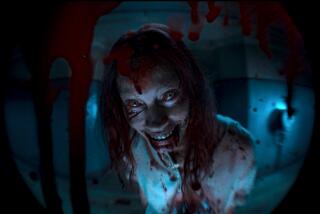Resident Evil Ushers in New Set-Top Standards
- Share via
It would be impossible to say enough complimentary things about Capcom’s Resident Evil for PlayStation. It is, quite frankly, a beautiful, sophisticated and engaging adventure that takes set-top gaming to its highest level yet.
No game on any platform even comes close to matching Resident Evil on playability or sheer technical grace. And as just the second wave of 32-bit games, Resident Evil demonstrates how much potential console units still hold.
What sets Resident Evil apart is that it defies categorization. Part mystery, part killfest, part puzzler, the game incorporates the best elements of many genres to create an experience that is both unique and universally appealing.
Much like Myst, Resident Evil is driven by a story that unfolds gradually and skillfully throughout the game. But Resident Evil does Myst one better by making the story change from game to game, giving it a considerably longer play life than most of the competition.
And if the story isn’t enough, players are armed to the teeth. For those who found Myst a little too cerebral, Resident Evil encourages the liberal use of violence to solve problems.
The game takes place in and around a mansion somewhere in the sticks. Players assume the identity of one of two soldiers assigned to find their comrades who disappeared on an earlier mission. Depending on which soldier (Jill or Chris) players choose, the story unfolds differently.
Both follow fairly similar lines. It doesn’t take much to deduce that something is amiss in the house. There are zombies and giant spiders wandering through it. Although this sounds like fairly standard video game tripe, it comes off seamlessly in the game.
The reason is the execution. Perspectives change from scene to scene. One minute players are looking at something with a first-person perspective. The next, they see their character from behind, or above or from knee-level. The resulting effect is a cinematic adventure that builds tension more effectively than almost any other video game.
For instance, any player with a pulse will jump out of her or his chair in one particularly frightening sequence involving attack dogs and a stained-glass window. At times, it’s easy to forget that Resident Evil is just a video game.
The game would not work, however, if the graphics weren’t as perfect as they are. Rooms are fully rendered with multiple light sources to create an ambience that is as moody as Myst but considerably more fluid. The music, too, establishes a tension that few games even aspire to.
After many hours of play, most video games tend to bore. Resident Evil demands attention and, even in quiet spots, refuses to be ignored. It alone justifies the expense of a PlayStation and shows off just how much power set-top gaming can have.
Aaron Curtiss can be reached via e-mail at aaron.curtiss@latimes.com
More to Read
The biggest entertainment stories
Get our big stories about Hollywood, film, television, music, arts, culture and more right in your inbox as soon as they publish.
You may occasionally receive promotional content from the Los Angeles Times.










